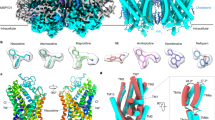Abstract
DOPAMINERGIC nigrostriatal neurones have recently been found to contain dopamine (DA) also in their dendrites1. Certain observations suggest a release of transmitter from these dendrites: depolarisation by potassium ions induces a release of 3H-DA from incubated tissue slices of rat substantia nigra2, and stimulation of the median forebrain bundle increases 3,4-dihydroxyphenylacetic acid, a major metabolic of DA3, in the mesencephalic region containing dopaminergic cell bodies and dendrites4, as well as in caudate–putamen, the terminal area. These similarities between terminal and somato-dendritic areas point to a similar regulation of DA metabolism and an active role of DA in both parts of the neurone. We have studied this question in a situation where the dopaminergic neurones are inhibited. γ-Butyrolactone (GBL) applied systemically, strongly reduces unit activity of the dopaminergic neurones in zona compacta of substantia nigra5. Under these conditions, the changes observed in the somato–dendritic complex differed markedly from those reported for the terminal area6–12.
This is a preview of subscription content, access via your institution
Access options
Subscribe to this journal
Receive 51 print issues and online access
$199.00 per year
only $3.90 per issue
Buy this article
- Purchase on Springer Link
- Instant access to full article PDF
Prices may be subject to local taxes which are calculated during checkout
Similar content being viewed by others
References
Björklund, A., and Lindvall, O., Brain Res., 83, 531–537 (1975).
Geffen, L. B., Jessell, T. M., Cuello, A. C., and Iversen, L. L., Nature, 260, 258–260 (1976).
Roffler-Tarlov, S., Sharman, D. F., and Tegerdine, P., Br. J. Pharmac., 42, 343–351 (1971). Wilk, S., Watson, E., and Travis, B., Eur. J. Pharmac., 30, 238–243 (1975).
Korf, J., Zieleman, M., and Westerink, B. H. C., Nature, 260, 257–258 (1976).
Roth, R. H., Walters, J. R., and Aghajanian, G. K., Frontiers in Catecholamine Research (edit. by Usdin, E., and Snyder, S.), 567–574 (Pergamon, New York, 1975).
Gessa, G. L., et al., Life Sci., 5, 1921–1930 (1966).
Aghajanian, G. K., and Roth, R. H., J. Pharmac. exp. Ther., 175, 131–138 (1970).
Walters, J. R., and Roth, R. H., Biochem. Pharmac., 21, 2111–2121 (1972).
Walters, J. R., Roth, R. H., and Aghajanian, G. K., J. Pharmac. exp. Ther., 186, 1630–1639 (1973).
Walters, J. R., and Roth, R. H., J. Pharmac. exp. Ther., 191, 82–91 (1974).
Kehr, W., Carlsson, A., Linqvist, M., Magnusson, T., and Atack, C., J. Pharm. Pharmac., 24, 744–747 (1972).
Stock, G., Magnusson, T., and Anden, N. E., Naunyn Schmeideberg's Arch. Pharmac., 278, 347–361 (1973).
Lichtensteiger, W., Prog. Histochem. Cytochem., 1, 185–276 (1970); Lichtensteiger, W., Lienhart, R., Hefti, F., and Felix, D., Brain Res. (in the press).
Schlumpf, M., Waser, P. G., Lichtensteiger, W., and Langemann, H., Biochem. Pharmac., 23, 2447–2449 (1974).
Palkovits, M., Brownstein, M., Saavedra, J. M., and Axelrod, J., Brain Res., 77, 137–149 (1974).
Hefti, F., and Lichtensteiger, W. J., 27, 647–649 (1976).
Einarsson, P., Hallman, H., and Jonsson, G., 53, 15–24 (1975).
Carlsson, A., Kehr, W., Lindqvist, M., Magnusson, T., and Atack, C. V., 24, 371–384 (1972).
Walters, J. R., and Roth, R. H., Biochem. Pharmac., 25, 649–654 (1976).
Koenig, J. F. R., and Klippel, R. A., The Rat Brain. A Stereotaxic Atlas (Williams and Wilkins, Baltimore, 1963).
Lowry, O. H., Rosebrough, N. J., Farr, A. L., and Randall, R. J., J. biol. Chem., 193, 265–275 (1951).
Lienhart, R., Lichtensteiger, W., and Langemann, H., Naunyn-Schmiedeberg's Arch. Pharmac., 286, 353–369 (1975).
Author information
Authors and Affiliations
Rights and permissions
About this article
Cite this article
HEFTI, F., LIENHART, R. & LICHTENSTEIGER, W. Transmitter metabolism in substantia nigra after inhibition of dopaminergic neurones by butyrolactone. Nature 263, 341–343 (1976). https://doi.org/10.1038/263341a0
Received:
Accepted:
Issue Date:
DOI: https://doi.org/10.1038/263341a0
This article is cited by
-
Dendritic release of dopamine in the substantia nigra
Nature (1981)
-
Influence of monoamine oxidase inhibition on the release of 3H-dopamine elicited by potassium and by amphetamine from the rat substantia nigra and corpus striatum
Naunyn-Schmiedeberg's Archives of Pharmacology (1980)
-
Effects of intranigral administration of dopamine agonists and antagonists and baclofen on concentrations of dopac and dopamine in the striatum and substantia nigra of the rat
Journal of Neural Transmission (1979)
Comments
By submitting a comment you agree to abide by our Terms and Community Guidelines. If you find something abusive or that does not comply with our terms or guidelines please flag it as inappropriate.



